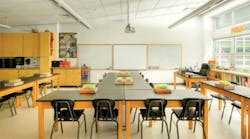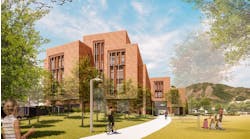A green school offers a healthful environment conducive to learning while saving energy, resources and money. Getting new and existing schools to deliver these results is an imperative that cannot be overlooked, but often those responsible for creating, planning, building and maintaining sustainable schools don't know where to begin.
The Center for Green Schools at the U.S. Green Building Council works to make sure people have the resources and information to make necessary changes. Its mission is to achieve green schools for everyone, and offer strategies that every school can use to become a greener learning environment:
1. Start where you are.
No education institution is too far behind to start improving the buildings where students learn. A green school can be new or old; any effort to make the school more healthful, more efficient and more conducive to environmental learning is a gain for all involved.
The Recovery School District of Louisiana (RSD) in New Orleans is one example of a district that, after Hurricanes Katrina and Rita, had no choice but to start where they were: far behind. Over the past five years, the staff has created a culture of renewal from academics to facilities. They set a goal of LEED silver certification and 30 percent energy savings for all of their rebuilt and renovated schools, which will total more than 80 schools. In addition, they have begun a rigorous indoor air quality program, hired an energy manager, entered into a public-private partnership to install large solar arrays and trained capital project management staff in LEED and green building. Healthful, high-performance schools are for every community and every child, no matter where you start.
2. Ready, set, start?
It's hard to know what to fix if you don't know where you stand. If a school wants to establish a recycling or composting program, understanding the kinds of waste being produced is helpful so the right items can be targeted. If schools want to save energy, administrators need to know how much energy is being used daily and where the biggest inefficiencies are. Having the right information upfront enables schools to measure success, and showing measurable success is the best way to get others on board.
For help measuring and tracking school waste streams and resource use, consult the EPA Waste Wise program. Kid-friendly energy audit tools are available through the Alliance for Climate Education, National Energy Education Development and the Department of Energy's kids activity website.
3. Benchmark energy use.
Any good facility manager will say that making one-off improvements without assessing the building as a whole is not a good idea. Yet, administrators sometimes forget the importance of assessment when it comes to energy use and efficiency. ENERGY STAR Portfolio Manager, a free, online program, has become the benchmarking tool for more than 28,000 schools: School and university leaders enter data and compare performance, while taking into account the age, square footage and amenities (such as kitchens and computer labs) of each school.
Other software programs and cloud-based services also can be helpful to monitor and track utility usage.
More Green School Strategies
4. Change the culture.
Whether a school is able to invest in capital improvements or not, changes in occupant behavior can have an enormous effect on two major focus areas of green schools: energy and health. Teams of teachers, staff and administration are trained to spot situations that may be harmful to student health through the EPA's Tools for Schools program, and various organizations provide training and resources for students and teachers to be champions of energy efficiency.
One example of the value of setting firm expectations for environmentally responsible school culture is Rocky Mountain High School in the Poudre (Colo.) School District. A few years ago, the principal of Rocky Mountain High School set up a code of conservation-minded conduct he called the "Lobo Way" (the school's mascot is the lobo). This 1970s school was able to cut its electricity usage by 50 percent over eight years and educate scores of environmentally literate young adults.
5. Signs are a must.
Green school buildings can and must be used as teaching tools. This can be done with signage that explains an interesting building component to occupants — but it can be much more than that.
At the LEED Gold Manassas Park Elementary in Manassas Park, Va., the three levels of the school are named for the floor, understory and canopy of the forest that abuts the school property. Classrooms are named for species that live in the forest. Outside, a tall pole measures how full the underground water cistern is and displays the progress of rainwater collection to students. The cistern area has been turned into an outdoor classroom, teaching students about stormwater runoff and its impact on the region.
No matter what green efforts are in place at a school or how well-designed the school building is, if occupants do not know what is happening around them, then the effort is falling short of its potential. Invest in good signage, and schools may get a change in culture in return.
6. Go behind the scenes.
If you want to know whether a school is accomplishing sustainability objectives, ask the on-the-ground experts. Custodial staff often have training on green cleaning methods or energy-efficiency initiatives. They know the buildings inside and out, and asking them for ideas is a great way to bring them onto the team and show appreciation for their work.
Take a look at the school-specific information about LEED for Existing Buildings: Operations & Maintenance for a comprehensive view of greener school facilities. Also explore the EPA's Buildings and Grounds checklist for specific questions to ask maintenance personnel.
7. Put kids in charge.
Parents, teachers and school administrators know that kids are second to no group in being able or willing to speak up about the importance of protecting the environment. Students across the nation are starting green clubs in schools with the help of teachers and school administration.
These students plant gardens on school property, calculate carbon footprints, assess school energy use, enforce a school's recycling program and much more. Encourage staff to help start a club, and let the kids run with it.
For a fun classroom and home energy audit for students, go to NOVA's teacher activity site on PBS.org. More green activities and lesson plans for kids can be found in the Sustainability Education Clearinghouse, found at greeneducationfoundation.org.
More Green School Strategies
8. You know it is dust, but what is it?
People don't always think about it, but dust is not just magically appearing gray clouds. It contains dust mites, cockroach dander and other particulates that can be very harmful to breathe, especially for kids with asthma or other respiratory problems. Nearly one in every 13 school-age kids suffers from asthma, which is the leading cause of absenteeism.
The EPA's Tools for Schools Indoor Air Quality program gives tips for keeping a healthful classroom — one of the simplest and most crucial steps is to de-clutter. Another simple and effective step is eliminating products intended to mask bad odors, such as air fresheners. These additional odors may become another asthma trigger within the classroom.
9. Carpooling programs.
Schools can start small, but a carpooling program can have a big effect. The more students or faculty in a car on the way to school, the less fossil fuel used and the less pollution emitted per person. Start in one or two classes to see if parents are interested. There are several ways to scale it up from there — from a simple bulletin board by the office to a paid service for online carpool coordination. Institutions also could start a campaign to get kids and families walking or biking to school.
Several online tools and resources exist to encourage carpooling and other car-free transportation to school. Safe Routes to Schools is the most well-known program and is active in education, outreach and grant-making. Other information can be found at carpooltoschool.com and gogreenstreets.org.
10. Test the waters.
When a facilities staff undergoes training, the group often reaches a point when all of the possible actions that could be taken to improve their school facilities overwhelm them. So, remember — there is nothing wrong with starting small. Pick one undertaking at one school or building and then expand to other efforts, deeper efforts and other schools.
There is more than one way to green a school. The goals of healthy, productive students and responsibly spent tax money do not rest with one particular organization or one particular pathway. The more excited, informed and creative schools and their staff get about greening a school, district or campus, the more resources and support they will receive.
Metzger is manager for the Center for Green Schools Fellows, Washington, D.C. She can be reached at [email protected].
Sidebar: School District of Philadelphia
In 2009, the School District of Philadelphia was one of 12 districts in the nation to participate in a USGBC pilot program for using LEED for Existing Buildings: O&M in K-12 school districts. In the district's first project, at Thurgood Marshall Elementary, staff members found that in order to work most effectively through the LEED system to be more inventive and experiment with their own systems and procedures. Schools may be surprised at what is possible if they start small and work their way toward transformation.


